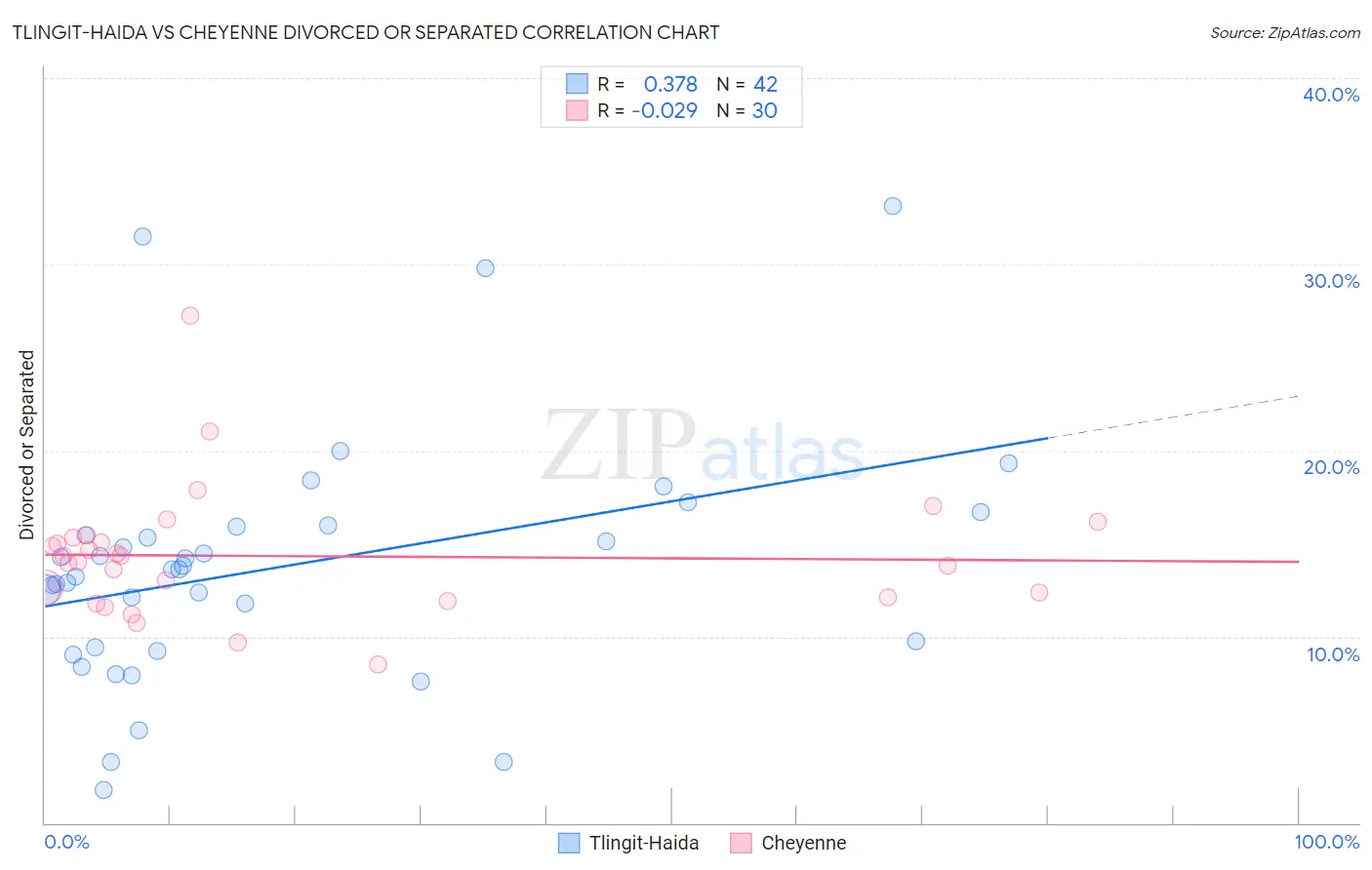Tlingit-Haida vs Cheyenne Divorced or Separated
COMPARE
Tlingit-Haida
Cheyenne
Divorced or Separated
Divorced or Separated Comparison
Tlingit-Haida
Cheyenne
13.2%
DIVORCED OR SEPARATED
0.0/ 100
METRIC RATING
306th/ 347
METRIC RANK
13.4%
DIVORCED OR SEPARATED
0.0/ 100
METRIC RATING
321st/ 347
METRIC RANK
Tlingit-Haida vs Cheyenne Divorced or Separated Correlation Chart
The statistical analysis conducted on geographies consisting of 60,872,098 people shows a mild positive correlation between the proportion of Tlingit-Haida and percentage of population currently divorced or separated in the United States with a correlation coefficient (R) of 0.378 and weighted average of 13.2%. Similarly, the statistical analysis conducted on geographies consisting of 80,717,753 people shows no correlation between the proportion of Cheyenne and percentage of population currently divorced or separated in the United States with a correlation coefficient (R) of -0.029 and weighted average of 13.4%, a difference of 1.5%.

Divorced or Separated Correlation Summary
| Measurement | Tlingit-Haida | Cheyenne |
| Minimum | 1.8% | 8.5% |
| Maximum | 33.1% | 27.2% |
| Range | 31.3% | 18.7% |
| Mean | 13.8% | 14.3% |
| Median | 13.6% | 14.1% |
| Interquartile 25% (IQ1) | 9.4% | 12.1% |
| Interquartile 75% (IQ3) | 15.9% | 15.3% |
| Interquartile Range (IQR) | 6.5% | 3.2% |
| Standard Deviation (Sample) | 6.6% | 3.5% |
| Standard Deviation (Population) | 6.5% | 3.4% |
Demographics Similar to Tlingit-Haida and Cheyenne by Divorced or Separated
In terms of divorced or separated, the demographic groups most similar to Tlingit-Haida are Chippewa (13.2%, a difference of 0.16%), Hopi (13.2%, a difference of 0.22%), French American Indian (13.2%, a difference of 0.25%), Ottawa (13.2%, a difference of 0.34%), and Cape Verdean (13.1%, a difference of 0.35%). Similarly, the demographic groups most similar to Cheyenne are Cajun (13.4%, a difference of 0.10%), Puget Sound Salish (13.4%, a difference of 0.16%), Cree (13.4%, a difference of 0.20%), Haitian (13.3%, a difference of 0.22%), and Tsimshian (13.3%, a difference of 0.24%).
| Demographics | Rating | Rank | Divorced or Separated |
| Cape Verdeans | 0.0 /100 | #303 | Tragic 13.1% |
| Hopi | 0.0 /100 | #304 | Tragic 13.2% |
| Chippewa | 0.0 /100 | #305 | Tragic 13.2% |
| Tlingit-Haida | 0.0 /100 | #306 | Tragic 13.2% |
| French American Indians | 0.0 /100 | #307 | Tragic 13.2% |
| Ottawa | 0.0 /100 | #308 | Tragic 13.2% |
| Americans | 0.0 /100 | #309 | Tragic 13.2% |
| Africans | 0.0 /100 | #310 | Tragic 13.2% |
| Sioux | 0.0 /100 | #311 | Tragic 13.2% |
| Blackfeet | 0.0 /100 | #312 | Tragic 13.3% |
| Immigrants | Nicaragua | 0.0 /100 | #313 | Tragic 13.3% |
| Yaqui | 0.0 /100 | #314 | Tragic 13.3% |
| Spanish Americans | 0.0 /100 | #315 | Tragic 13.3% |
| Tsimshian | 0.0 /100 | #316 | Tragic 13.3% |
| Haitians | 0.0 /100 | #317 | Tragic 13.3% |
| Cree | 0.0 /100 | #318 | Tragic 13.4% |
| Puget Sound Salish | 0.0 /100 | #319 | Tragic 13.4% |
| Cajuns | 0.0 /100 | #320 | Tragic 13.4% |
| Cheyenne | 0.0 /100 | #321 | Tragic 13.4% |
| Immigrants | Haiti | 0.0 /100 | #322 | Tragic 13.4% |
| U.S. Virgin Islanders | 0.0 /100 | #323 | Tragic 13.4% |